From her images of the "great, dark trees of the Big Woods" to the endless grass of the prairies in the west, Laura Ingalls Wilder's depictions of frontier life for America's pioneers in her beloved "Little House" series of children's books have won her countless fans. Now the writer's autobiography, from which she drew the material that has delighted readers for decades, will be published this autumn for the first time, more than 80 years after she first wrote it.
Wilder's Pioneer Girl, the story of her childhood, was begun by the author in 1930, when she was in her early 60s, but was rejected by editors at the time. It contains stories omitted from her novels, tales that Wilder herself felt "would not be appropriate" for children, such as her family's sojourn in the town of Burr Oak, where she once saw a man became so drunk that, when he lit a cigar, the whisky fumes on his breath ignited and killed him instantly. In another recollection, a shopkeeper drags his wife around by her hair, pours kerosene on the floor of his house, and sets their bedroom on fire.
Wilder's memoir also paints a different picture of her father, Charles Ingalls, known in the novels as Pa. Although the real man's character is essentially the same as the version in the novels – affectionate, musical and restless to move on through America's frontier – he is, said the book's publisher, the South Dakota Historical Society Press, clearly "romanticised and idealised". In Wilder's autobiography, he is described sneaking his family out of town in the middle of the night after failing to negotiate the rent with the landlord, justifying the flit by calling the man a "rich old skinflint".
Detailing the Ingalls family's journey through Kansas, Missouri, Wisconsin, Minnesota, Iowa, back to Minnesota, and on to Dakota Territory, the book failed to win over publishers at the time. So Wilder reworked it into her series of children's books, starting with Little House in the Big Woods, in which a four-year-old Laura lives "in the Big Woods of Wisconsin, in a little gray house made of logs", with her Pa and Ma, her sisters Mary and Carrie, and their dog, Jack. "As far as a man could go to the north in a day, or a week, or a whole month, there was nothing but woods. There were no houses."
The South Dakota Historical Society Press will release a researched version of the book for the first time this autumn, including more than 100 images, maps, and hundreds of annotations drawn by editor Pamela Smith Hill, author of a biography of Wilder, from additional manuscripts, diaries and letters.
"Wilder's fiction, her autobiography, and her real childhood as she lived it are three distinct things, but they are all closely intertwined, and readers will enjoy seeing how they reflect one another. Even more interesting, though, are the places where one story differs from another, and Pioneer Girl: The Annotated Edition explores these differences too," said Nancy Koupal, the publisher's director.
"Some of Wilder's lowest, unhappiest times, such as her sojourn in Burr Oak, Iowa, never made it into her fiction. On the other hand, as a novelist, Wilder made other experiences seem even harder than they were; for example, we know that the Ingalls family and the community of De Smet were not quite so isolated during the hard winter of 1880-81 as readers of The Long Winter would believe."
Wilder never wrote in her fiction about her little brother Charles Frederick, who died aged just nine months. The unpleasant character Nellie Oleson, meanwhile, is revealed by the memoir to be an amalgam of three disagreeable people Wilder knew as a child.
The memoir opens as the Ingalls family settle on the Osage Indian reserve in Kansas. "Once upon a time years and years ago, Pa stopped the horses and the wagon they were hauling away out on the prairie in Indian Territory," Wilder writes. "I lay and looked through the opening in the wagon over at the campfire and Pa and Ma sitting there. It was lonesome and so still with the stars shining down on the great, flat land where no one lived."
Koupal pointed to Wilder's "gift for descriptive prose and a true love of the prairie landscape", which she said was displayed in the memoir, highlighting the writer's description in the autobiography of the sunset on her first journey into Dakota Territory in September 1879. "The sun sank lower and lower until, looking like a ball of pulsing, liquid light it sank gloriously in clouds of crimson and silver. Cold purple shadows rose in the east; crept slowly around the horizon, then gathered above in depth on depth of darkness from which the stars swung low and bright."
Koupal called Wilder "a critical figure in American literature".
"It's only natural that readers will want to know her better," she said. "I think it is Wilder's essential familiarity that appeals to readers. For isn't that what makes her special? To her contemporaries, she was literally the girl next door (or on the next quarter section). Yet, as an author, she makes her readers see what is extraordinary and worth telling in the everyday lives of everyday people. This skill makes her one of the great storytellers of the pioneer saga in the United States."
Wilder would go on to publish Little House in the Big Woods in 1932. Little House on the Prairie would follow in 1935, after an account of her husband Almanzo Wilder's childhood, Farmer Boy, in 1933. Wilder wrote eight novels about her life, also including The Long Winter and By the Shores of Silver Lake, with four more published after her death in 1957 at the age of 90, compiled based on her manuscripts, diaries and letters.

Comments (…)
Sign in or create your Guardian account to join the discussion